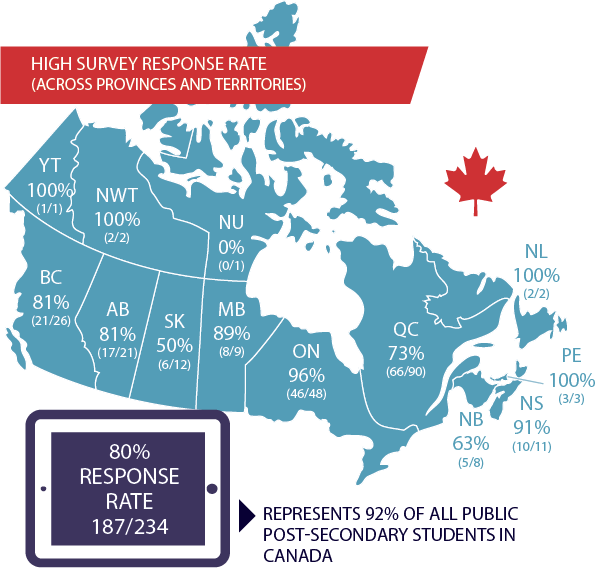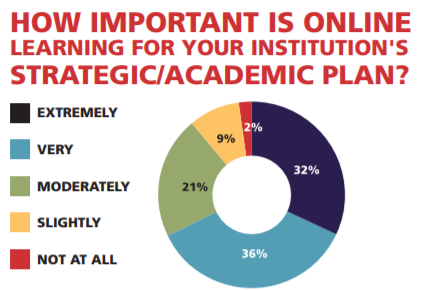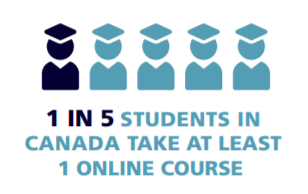Tracking enrollments in online and distance education in Canada: 2018
Published by: WCET | 3/26/2019
Tags: Collaboration/Community, Data And Analytics, Digital Learning, Distance Education, Online Learning, Research, Survey
Published by: WCET | 3/26/2019
Tags: Collaboration/Community, Data And Analytics, Digital Learning, Distance Education, Online Learning, Research, Survey
WCET plays an integral role in advising the Canadian National Survey of Online and Distance Education. This is the second year of the survey and the following blog contains the most recent results. Thanks Tricia Donovan!
–Erin Walton, contract editor for WCET
In Canada, about one in twelve (8%) of all courses are taught online. This is just one of the results of the 2018 Canadian National Survey of Online and Distance Education. This is the second year for the survey and the only effort to capture national data regarding what is happening in online, distance, and blended/hybrid courses at Canada’s publicly funded post-secondary institutions.

We are glad to reach the second year mark after a few false starts and with the on-going support from WCET’s very own Russ Poulin. The Canadian National Survey is a team of individual researchers led by myself, Dr. Tony Bates, and Dr. Jeff Seaman from the Babson Survey Research Group.
In 2018, we established the Canadian Digital Learning Research Association (CDLRA) to support the work of the bilingual survey. We are committed to sharing the data and receive support from OCAS, the application system for Ontario colleges, Ontario to house the open data for academics to conduct further research on the results.
Responsibility for post-secondary education in Canada falls under provincial and territorial jurisdiction – there is no national oversight or coordinating body that would collect data on what is happening in online and digital education (or other areas in post-secondary for that matter).
As such, it is truly a remarkable feat to have had the opportunity to survey and to garner the results we have in just our second year of surveying. This could not have been possible without the support of our partners (WCET and Babson), our sponsors (provincial eCampuses, Contact North, Pearson Canada, OCAS, and D2L), and the willingness of post-secondary institutions to discover, share, and find value in the data. We are a thankful research team.
Online learning in Canada is very well established, with many institutions offering online education for 15 years or longer. In Canada, there are a handful of institutions that are 100% dedicated completely to online:

There are also a number of institutions with a high percentage of online activity:
And, we learned that there exist a number of post-secondary institutions in Canada with a very high number of online course enrollments as can be seen in the following list:
Across Canada today, there are four provincial eCampus organizations (BCcampus, Campus Manitoba, Contact North, and eCampusOntario). The eCampus organizations serve as catalysts for maximizing collaboration and sharing of best practices, lessons and strategies learned, quality assurance, professional development for teaching and learning, open educational resources, and more. Alberta supported an eCampus organization from 2002-2017 and both Quebec and the Atlantic provinces have been or are exploring the opportunity to establish one.
Full disclosure: I am a strong believer and biased advocate for inter-institutional collaboration and initiatives that support excellence in online teaching and learning and student success. I served as the Executive Director of eCampusAlberta for 14.5 years; co-led a WCET-led group focused on consortia issues with Russ Poulin, David Porter (BCcampus and eCampusOntario), and Kevin Corcoran (Connecticut Distance Learning Consortium) for a few years.
We are committed to ensuring that the survey results add value to those working in online and digital education. In the open-ended comments, some institutions thanked us for asking the questions and others asked us to share how institutions are tracking this data. In the absence of provincial reporting requirements, this data has not been consistently tracked nor measured at many institutions.
Some senior executives have shared that the survey has served as a ‘wake-up’ call for them to develop the processes required to track this data, which we think is a good thing.

Online learning is growing in post-secondary education in Canada and we think it is important to surface what is happening, what is working well, and help support a network of advocates who are focused on increasing access and flexibility for students and faculty. By developing an understanding of the strategic importance of online learning and the identification of barriers in expanding it, we hope to collectively influence decisions that will further inform and support success.
One area of the survey on which Russ Poulin and I focused was on the issue of definitions in online learning. Both of us have been active in online learning for twenty years or more – and we were well aware of the lack of agreement on definitions. In fact, Russ is now on a U.S. Department of Education subcommittee that is once again tackling the distance education definition.
Perhaps that is why we were pleasantly surprised to discover that, when we asked institutions if they have a definition for each of the delivery modalities, we also asked them if their definition matched one presented by the survey. When we look at the National figures, we found:
The results are even stronger in some provinces such as in Ontario, where responding institutions shared 83% agreement with the definition provided for an online course.
Online Course Definition: A form of distance education where the primary delivery mechanism is via the Internet. These could be delivered synchronously or asynchronously. All instruction is conducted at a distance.
This is a small but mighty finding! If we can agree on what it is we are talking about, comparison of data becomes more meaningful. However, with less than two-thirds agreement on of these definitions there is much work left to be done. For those institutions that do not yet have a definition, we would encourage them to start with the definitions provided by the survey – simply for the sake of efficacy.

We have the unique privilege of being able to administer the policy and practice portions of the 2019 Canadian survey to a representative sample of chief academic officers (the highest-ranking individual responsible for the academic programs, typical titles are provost, academic vice president, etc.) in the United States in 2018. The objective was to compare the experiences and opinions of those at institutions with for-credit distance course offering, so the responses from the 172 Canadian institutions that have for-credit online offerings were compared to a representative random sample of US academic leaders from 112 institutions with for-credit online offerings.
In general, the pattern of responses between the two countries is quite similar, and where there are differences, it is the Canadian respondents who are the more positive toward online education.
The results are being very well received by the provincial eCampuses, provincial ministries, and post-secondary institutions. We are committed to adding value to the institutions through our collection of data and sharing the results that will help to shape practice, inform policy, and support success.
And to all who might be interested – we are preparing the 2019 Canadian Survey to be released in April and data collection will close at the end of May, 2019.
For more on the results, please visit: https://onlinelearningsurveycanada.ca/publications. We have posted our Public Report, Technical Report, and a couple of our Regional Sub-Reports (Ontario and Western Canada are complete, Quebec and Atlantic Canada are in the works). The key results are also available in our first Infographic, which was designed by eCampusOntario. The digital assets of the Infographic are available online, and we encourage you to download and use them in your presentations to help create awareness of the survey results.
Please direct any questions you may have about the survey to: Tricia Donovan.

Tricia Donovan
Executive Director
Canadian Digital Learning Research Association
tdonovan@onlinelearningsurveycanada.ca

1 reply on “Tracking enrollments in online and distance education in Canada: 2018”
Would like to see a similar article or report for the United States or individual states if available.